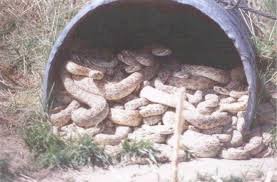Glad to hear the young lady survived and sorry to hear about the dog's fate.
After 30 years in the oilfield on producing well sites, new drilling locations, field offices, pipe yards, compressor stations, etc, in states like Texas, Oklahoma, Louisiana, California, Colorado, etc, I have seen my share of rattlers in various situations.
I have never been bitten, but have killed several. The shovel was my main death instrument! Killing them on a lease road (on caliche) was fun to video (haha).
Some situations and what oilfield workers have to deal with daily:
1. Around pumping units and tank farm tanks, these little menaces like to hide out under equipment in sandy soil. You have to watch where you walk.
2. Gas meter house - typically a small porto-potty sized metal building housing a gas meter and plumbing going in and out sitting in the sun. Before opening the metal door, it's best to whack it with a stick and listen for the peeved off rattler you just woke up. Tie a rope on the door and open it from 10 feet away.
3.Compressor stations. Lots of noise from the large heat exchanger fan. Must be very careful going in buildings and opening doors. Around 55-gallon drums is a great place for a snake to hide waiting for a field mouse to strut by.
4. Pipe yards and equipment storage areas are loaded with places for snakes to lay low or nest. I have seen a snake come out the end of a 6" diameter pipe on a rack with other pipe.
5. Scruffy areas around well sites. Many time I have almost stepped on a rattler just walking from the truck to the pumping unit.
Leather boots are a must, and heavy coveralls over denims. I always carried a stick. The major oil companies do not allow any firearms on their sites. Many independent oil companies follow that rule, but it is bent from time to time.

